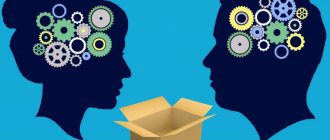We are all different. And we are talking not only about the external data that nature gave us. We differ from each other in behavior, reactions to certain situations, characteristics of interaction with society, mentality, etc. Human development has long been the object of study by psychologists and scientists. As a result of observations of people that have been going on since ancient times, various psychological typologies of personality have emerged.
They say that if you understand typologies, you can make your life a lot easier: firstly, you will understand yourself, your characteristics, strengths and weaknesses; secondly, at a minimum, learn to interact effectively with people. Is this really so and what personality typologies will help “reveal all the cards” of a person, we will tell you in this article.
Welcome to the world of amazing people!
Silent history
Personality typology in psychology is interpreted as a system of individual attitudes and behavioral stereotypes, formed to explain the differences between people.
Even in ancient times, scientists, writers and philosophers classified people according to various criteria. Aristotle introduced the concept of “virtue”. This is how he outlined the internal order and structure of the soul. Virtues, according to the philosopher, are divided into moral (ethical) and mental (reasonable).
Ethical virtues represent a mean between two extremes: excess and deficiency. They are characterized by courage, majesty, friendliness, ambition, truthfulness, courtesy, wisdom, etc. Regarding moral virtue, Aristotle said that it is “the ability to do the best in everything that concerns pleasure and pain, and vice is its opposite.”
Ethical virtues of character, according to the philosopher, are formed in the process of life and as a person gains experience, and rational virtues - through learning [A. Chanyshev, 1987].
In 314 BC. Theophrastus proposed his typology. For him, human character is a set of mental properties that are manifested in actions and words. He divided people into 30 types, which he described in detail in his work “Characters”. The names of the types speak for themselves: pretender, flatterer, gossip, talker, impolite person, curmudgeon, braggart, etc. [ABOUT. Freidenberg, 1941]
Hippocrates created the doctrine of the internal juices of man. He highlighted:
- yellow bile;
- black bile;
- blood;
- slime.
Depending on which fluid dominates in a person, he identified the following types of temperament: choleric, phlegmatic, sanguine and melancholic [B. Petrovsky, 1977].
This is one of the oldest personality typologies, which, despite the generality of characteristics, is still used today. We will return to it later.
Around the middle of the 20th century, the study of personality began to be given special importance. Various options have emerged for classifying people according to their distinctive characteristics. Among them were:
- Personality typologies of Ernst Kretschmer and William Sheldon: they explain the relationship between body type and temperament.
- Types of experiences: introverted, extroverted, ambiequal, coartistic, dilatory. This classification was put forward by Hermann Rorschach.
- Types of representations by Erich Rudolf Ensch : integral, differentiated.
- Forms of life activity , which, according to Eduard Spranger, are divided into aesthetic, religious, economic, social, power, theoretical, etc. [Org, 2017].
Most of the typologies proposed during that period have historical value and are practically not used today. But among them there are those that became the foundation for the development of psychology. We propose to consider them and more modern classifications of personality typologies further.
So what was Hippocrates talking about?
According to the teachings of Hippocrates, temperament is a certain behavior of a person, which is associated with the predominance of a specific fluid in his body. He believed that the presence of mucus (lymph) in large quantities determines the degree of balance of a person, i.e. the more lymph, the calmer the person.
A high concentration of yellow bile makes a person impulsive, black bile - sad and melancholic, and blood - energetic. Based on these data, Hippocrates identified four types of temperament that explain human behavior:
- Sanguine temperament: One who has this type of temperament is characterized by activity and balance. This is a fascinating personality who willingly takes part in various events. She is characterized by a quick change of emotions, bright facial expressions and pantomime, and expressive laughter. Sanguine people have a high sensitivity threshold, so they do not react to distractions (sound, light). People of this type of temperament are distinguished by their efficiency and energy; they easily adapt to new conditions due to their flexibility and quickly switch attention from one thing to another. They are also distinguished by their speed of reaction, which is expressed in movements, speech, and love vivid impressions. These are typical extroverts. The dominant fluid is blood.
- Choleric temperament: choleric people are highly reactive, which is why they are often quick-tempered, impulsive, and unrestrained. Unlike sanguine people, such individuals are less flexible, therefore they strive to be stable in everything and have difficulty switching their attention. The dominant fluid is bile.
- Phlegmatic temperament: people of this type of temperament are active and balanced. There is little that can piss them off and force them to express their feelings. They are unemotional; it will be very difficult to make them laugh or cry. Phlegmatic people's facial expressions and gestures are monotonous and express practically nothing. They have difficulty adapting to new circumstances and shifting their attention. Such people live “within themselves”, it is difficult for them to make acquaintances, they do not like to be the center of attention, phlegmatic people are introverts. The dominant liquid is mucus.
- Melancholic temperament: melancholic people are characterized by low reactivity and high sensitivity. Such people are easy to offend; they can burst into tears even for a minor reason. They have inexpressive facial expressions, a quiet voice, and slow movements. Melancholic people get tired quickly. Such people are insecure and find it extremely difficult to adapt to a new environment, although in familiar circles they can be very sociable and tactful. As a rule, these are introverts. The dominant liquid is black bile [Yu. Aleksandrovsky, 2021].
Surely, reading the descriptions of each type of temperament, you found something similar to your character. It is almost impossible to meet, for example, a sanguine person or a choleric person in their pure form, because... Each personality is a combination of all four types of temperament.
Moreover, there is always one dominant type, and all the others complement it. If a person has all four types of temperament in approximately equal proportions, such a person is called a tetravert. To most accurately determine the type of temperament, it is enough to take the Hans Eysenck personality questionnaire or the Pavlovian temperament questionnaire (“Strelyau Questionnaire”).
Jung's personality typology
The teachings of Carl Gustav Jung, a Swiss psychologist and psychiatrist, were based on the observation that some people's lives can be directed towards their own interests and interactions with the outside world, while others can be directed towards their own inner world. Based on this, he identified two main types of people:
- Extroverts: the consciousness of a person of this type of personality is directed to the outer world, and issues of the inner world always remain in the background.
- Introverts: the personality’s psyche is focused on internal processes, the outside world is of little interest to them.
In simple terms, an extrovert will always be happy to spend time with people, he is sociable and open, while an introvert will prefer privacy with himself, he is not so sociable and does not like to be the center of attention.
Jung divided personalities not only according to the universal criteria of extraversion and introversion, but also according to psychological functions, which included thinking, intuition, feeling, sensation. As a rule, one of these functions predominates over the others, forming a certain psychological type.
He divided functions into rational ones, which lie in the sphere of the mind (thinking, feeling) and irrational ones, which are outside the mind (sensation, intuition). The dominant function suppresses the opposite function, for example, intuition excludes sensation, and thinking excludes feeling [D. Sharp, 2008].
Thus, eight personality typologies were identified:
- Extroverted thinking type: a person perceives information through objective facts and reduces everything he encounters into a single scheme, with the help of which he then explains all other phenomena. He has good organizational skills and prioritizes global plans over individual plans.
- Introverted thinking type: such a person perceives reality through subjective internal perception. A person with such a psychotype, when studying a question, gets to the very core of the essence. He also follows his ideas, like the extroverted thinking type, only he does not develop them “outside”, but deepens them “inside”.
- Extroverted feeling type: a person perceives the world through his own senses, paying attention even to small details. He is impulsive, sociable and has flexible behavior, but is not very intelligent.
- Introverted Sensing Type: These people focus on their own internal emotions and feelings. Outwardly, they look calm and even passive, because their energy is aimed at processing internal sensations. As a rule, such individuals are closed and constantly engage in introspection, but at the same time maintain reasonable self-control.
- Extroverted Feeling Type: This type of person easily perceives the intentions of others. It is important for him to understand what the main values of the environment in which he is located are, to correspond to them, and for others to correspond to these values. This personality type is mainly found in women, because most often it is the fair sex who live with sensations that interfere with thinking.
- Introverted feeling type: a person of this type of personality has a sensitive perception of the surrounding reality and is prone to deep inner experiences. He is distinguished by silence, secrecy, he is a mystery to others, because... The true face is hidden behind a mask.
- Extroverted intuitive type: this type of personality is characterized by an endless search for new opportunities and excessive enthusiasm for prospects, which leads to a constant change of activity. A person of this type easily charges people with his energy, but at the same time he cares little about his health, which he can lose in the pursuit of something new.
- Introverted intuitive type: such a person is able to grasp what others cannot. As a rule, people of this type become creators and create something outside the usual, and some of them remain “unrecognized geniuses” because of their non-standard view of things [K. Jung, 2001].
Carl Gustav Jung devoted about twenty years to the study of personality types. He described his research and observations in detail in the book “Psychological Types.” Subsequently, this typology continued its development in the works of other scientists, in particular, Isabel Briggs Myers developed her own typology, which was based on the teachings of Jung. By the way, you can take the Myers Briggs Personality Type Test (MBTI) here .
Introverted thinking type (IMT).
BMI thinks logically, but his thoughts are hardly connected with the real outside world. First, he has the idea itself, and then he looks for confirmation of it in the objects around him. That is, he supplies facts to his formula, rather than creating a formula as a result of studying the facts. Moreover, if there is no evidence that he is right, he calmly ignores it.
Convincing BMI of something that contradicts his own point of view is quite a challenge . Often this is simply not possible. He is firm in his convictions and will change them only if he comes to it himself. The more he is dissuaded from an idea, the more committed he is to it. In principle, he has no need to share his thoughts; he is in no hurry to open them to the world or seek support from it.
This is a great theorist, not an activist; he does not try to find out everything at once. He is much more interested in the depth of this knowledge. That is why this type, as a rule, does not have many hobbies, but the existing ones are thoroughly mastered. Such an introvert is a very paradoxical person:
- has deep knowledge in specific areas, but turns out to be a bad teacher, does not know how to convey information that he understands perfectly in an accessible and comprehensive manner;
- in the eyes of those around him, he is domineering, unapproachable, arrogant, cold, sometimes embittered, but the closer people get to him, the more they warm up to him, see him naive, “lost,” and begin to value his closeness;
- when there is a discrepancy between ideas - his own and public ones - he is protected from the opinions of others to such an extent that he sometimes ignores the most obvious and undeniable arguments. Even constructive criticism may not be accepted if it goes against his subjective beliefs;
- can admit the most daring, daring, dangerous thoughts, but when it comes to expressing or actively implementing even the most harmless ideas, he is timid and gives in.
Tends to comprehend everything that happens to him . He even tries to understand emotions and feelings with his brain, and since he is not very good at this, he simply suppresses all experiences or abstracts from them. When communicating, he tries to be polite and kind, but does it with caution, since his outward cordiality is caused by a subconscious desire to “disarm” his interlocutor.
BMI is very secretive , stubborn, and cannot be influenced by others when achieving his goals. Constantly experiences doubts, creates restrictions, and is cautious. In this regard, he is isolated and secluded. It is difficult for him to express himself in such a way that everyone understands the essence of his words, which is why he sometimes considers himself unheard, lonely, and others as stupid. But if this type nevertheless finds someone who understands him, then he begins to overestimate and idealize this person.
The main advantages are depth of knowledge, ability to get to the bottom of things, thoroughness. Cons: Poorly developed social skills, inability to understand people.
DISC personality typology
DISC is a four-quadrant behavioral model that explains people's behavior in certain circumstances. This model does not take into account a person’s mental abilities, experience, education and other characteristics, but identifies four aspects that speak about a person’s preferences:
- d ominance – dominant, “red” (D);
- i nducement – influencing, “yellow” (I) ;
- s teadiness – stable, “green” (S);
- c ompliance – conscientious, “blue” (C) .
The founder of this personality typology is William Moulton Marston, psychologist, comic book author and creator of the polygraph. He believed that a person's behavior depends on how positively he perceives the environment and on the speed of his reaction to various situations. He described his teachings in the book “The Emotions of Ordinary People”; later they became the foundation for the development of the DISC typology [Hr-director, 2021]:
To better understand what we are talking about, let's take a closer look at each personality type:
- Dominant, “red” (D): the main motivation of such people is victory. They do not tolerate defeat and always strive to be leaders. They are driven by passion and competition. Strengths are the ability to work for results, an active life position, determination, flexibility and endurance. But at the same time, they cannot always find a common language with others, often lose sight of details and are prone to aggression if they are under stress. They can be excellent managers and formal leaders.
- Influential, “Yellow” (I): They are motivated by new opportunities and recognition. “Yellows” are characterized by enthusiasm, a positive outlook on life and energy; it is important for them to be in the center of attention. Such people have unconventional thinking, goodwill, and creativity. Impulsiveness, unpunctuality and lack of attention to detail are their weaknesses. They make good specialists in the creative field or HR services, because “yellows” know how to motivate people and resolve conflicts.
- Stable, “green” (S): people of this type strive for consistency and really dislike change. They are always ready to listen and support; they are born psychologists. The main value of “greens” is good relationships in the family, at work, and with friends. Order in everything, attention to detail, reliability are their strong point. But there are also disadvantages: it is difficult for them to refuse, they talk little about problems and are often touchy, which leads to psychosomatic disorders.
- Conscientious, “blue”, (C): these are fighters for what is right and lovers of consistency in business. Making a mistake is unacceptable to them. “Blues” do not express their emotions, they are closed and secretive, preferring loneliness. People of this type are very neat, pedantic and completely inflexible, and when stressed they often withdraw into themselves. Any position that requires accuracy, attentiveness and scrupulousness (accounting, human resources department, etc.) is suitable for them [HR-Portal, 2019].
As a rule, each of us contains all four personality types, but one of them will dominate. This typology is widely used in personnel selection to assess how well the candidate’s natural qualities match the current position.
Social typologies of personality
The peculiarities of personality formation are explained not only by psychology, but also by the influence of culture, history, and socio-economic living conditions.
Erich Fromm, a German-American psychologist, studied the issue of personality development since the end of the Middle Ages and came to the conclusion that isolation, loneliness, alienation are an integral part of human life, and that each historical period when humanity fought for its freedom and development, in its own way influenced the formation of behavior and attitudes.
Based on his observations, he identified five types of social character:
- Receptive orientation: people of this nature underestimate their potential and believe that they cannot be a source of anything good. They depend on the opinions of others, are not independent and constantly need approval and praise. The position of such a person is to be loved, not to love.
- Exploitative orientation: such people always look for their own benefit in everything. They achieve goals with strength and intelligence and are often ready to deceive and borrow other people's ideas for the sake of success.
- Acquisitive orientation: these individuals are very dependent on material goods, they are also called “hoarders”, because the more things they have, the calmer they feel. At the same time, they do not like to spend money, they constantly think about the past, and something new causes them fear.
- Market orientation: and here we are talking about the constant desire for financial success and the search for commercial gain. This is why people with a similar character establish any connections. Prestige and power are important to them; they clearly demonstrate their personal traits in order to look “more expensive” in the eyes of others.
- Fruitful orientation: this type of character, according to the scientist, is the ultimate goal in human development. Such people are calm, honest, independent, and prone to socially useful actions.
Erich Fromm divided these types of characters into fruitful (market and fruitful orientations) and unfruitful (receptive, acquisitive and exploitative orientations). Like other typologies, these types do not exist in a pure form, but are a combination of dominant and auxiliary character types [E, Fromm, 2006].
Eduard Spranger, a German philosopher of life, teacher, psychologist, in his book “Life Forms” identified six main personality types, each of which differs in perception of reality, values, motivation, etc. Here they are:
- Theoretical person: the highest form of activity for him is knowledge. It is important for him to be independent of specific goals; other values fade into the background.
- An economic person: it is important for him to benefit from everything to achieve his goals, so he saves resources.
- Aesthetic person: the highest value of the individual is harmony and aesthetics, the external world is assessed from the point of view of grace and suitability to the situation.
- A social person: love is the main principle of his life, and it must carry a religious meaning.
- Powerful person: Dominance over others is the dominant goal of the individual. He eschews any restrictions, and his boundless imagination helps to implement global projects that bring him fame.
- Religious person : focused on searching for the meaning of life and higher spiritual power [IP RAS, 2018].
Eduard Spranger believed that raising a child should be based on an understanding of what type of orientation he belongs to. Based on this, the teacher must instill in students certain life orientations.
Introverted feeling type (ITS).
No matter how paradoxical it may sound, the ICT gives the impression of a cold, indifferent person, detached from the world in his feelings. Those around him consider him indifferent in almost everything, calm, unperturbed. He really looks silent, difficult to reach, incomprehensible. But this is only the outer shell. As cold as this type is on the outside, he is just as passionate on the inside. His feelings are deep, intense, strong. But they really play a greater role for HCI than the emotions of other people or the need to express inner feelings.
Jung believed that among representatives of this type there are much more women than men. Their subjective values are so important to them that they sometimes tend to exaggerate them, make them more intense, or even invent them and instill them in themselves. What they cope with successfully. Among them there are often melancholic people in the full sense of the word. In relationships they prefer:
- adhere to safety, tranquility, the golden mean in everything, do not resort to extremes or risks;
- fence off from passion, vivid manifestations of feelings, impulses. They themselves cannot be passionate outwardly, and if their partner turns out to be so, then they close themselves off from him, move away;
- do not dominate people, but unconsciously still sometimes do it. In this case, their influence takes on the appearance of suffocating and constraining. Their loved ones begin to feel that they have been placed within the framework of a non-existent ideal and any deviation from it will force the ICT to ignore or completely renounce their relatives;
- constantly look for flaws, deviations from the “norm” in relationships. Therefore, they often doubt, experience groundless suspicions, and jealousy. In more rare cases, they show paranoia.
An introvert of this type is very protective of his feelings and tries to protect them from any interference. If someone around you shows their impulses and emotions publicly, the ICT will first try to show neutrality. Perhaps with a little bit of criticism, teaching, or superiority. But the stronger and more assertive the emotional reaction of the interlocutor, the greater the chance that the introvert will abruptly and coldly stop such behavior.
They are always in search of “ideal”, sublime, standard feelings, and simply do not exchange for less. They absolutely need everything to be as in classic novels and melodramas - purely, spiritually, platonically, unconditionally. They often associate exemplary experiences with some kind of spirituality, religiosity, or poetry.
To become the best version of oneself, it is advisable for the HCI to approach affairs with greater internal dispassion (external is enough) and not be afraid to take control into one’s own hands and take initiative .
So why do we need all this?
Today there are so many personality typologies that you involuntarily begin to doubt whether you need to bother yourself with them? The answer is clear – of course you need it! But just don’t score, but at least show interest in them.
First of all, the ability to understand psychotypes is useful for ourselves. If a person understands what type of personality he is, he will know his strengths and weaknesses, which means he will be able to competently manage them. This is a way to discover new opportunities for yourself, because often people tend to follow stereotypes or advice rather than listen to their own nature.
This is the case when a born speaker goes to work as an accountant, because, as his mother said, he will always have some money. As a result, no pleasure from work, no energy and no future prospects.
Cholerics, for example, make good bosses. They can handle any job that requires a lot of energy: journalist, coach, teacher, etc. Sanguine people easily find companionship, they can lead people, and they have good organizational skills. Phlegmatic people are strong in precise disciplines, while melancholic people are hard workers who love to work alone and require attention to detail.
As you can see, knowledge of the fundamental typology of Hippocrates’ personality already gives an understanding of what’s what. Now imagine what will happen if a sanguine person is seated at the mathematician’s table, and even alone?
Almost all HR specialists use various methods for assessing personality typology in their work. This is necessary both in personnel selection and in personnel changes, because an employee’s good results in an ordinary position do not always indicate that he will be an excellent leader; perhaps he lacks a natural manager, so a comprehensive assessment of personnel is important.
Surely, each of us has friends with whom we just can’t find a common language, or even some we consider, as they say, “not of this world.” There may be a conflict and misunderstanding with someone, because often people who are accustomed to being open with others, sociable and energetic perceive the slowness or isolation of their interlocutor, friend or colleague, as a kind of challenge, a negative personal attitude, which, naturally, is a mistake .
It is important to understand that there are no bad personality types, there are people with their own characteristics of character and behavior that are inherent to them by nature. It is the ability to assess a psychotype that helps to find a common language with others, prevent and resolve conflicts, and even agree on something.
And it is also important to understand that there are personality types that, in tandem, provide maximum or minimum productivity. If we look at the example of the DISC model, “red” interact best with “yellow”, but it is better not to pair them with “blue”, because These are two diametrically opposed personalities.
If you correctly consider the information about what type of personality your interlocutor (relative, colleague) belongs to, you can easily find the necessary levers to achieve maximum efficiency in communication. For example, with “yellows” you need to be positive in your communication, more often interested in their opinions, and to argue your point of view, refer to the views of authoritative individuals. You shouldn’t talk only about business with the “greens”. Informal communication is best suited to resolve various issues [O. Knysh, 2019].
Moreover, according to some psychologists, each personality type has its own illnesses. More precisely, if some character trait of a person is exaggerated or, conversely, strengthened, then mental abnormalities may appear. This relationship is clearly shown by the “7 radicals” personality assessment method, where all the names of radicals are derived from the names of diseases: schizoid, epileptoid, hysterical, hyperthymic, paranoid, emotive, anxious [V. Ponomarenko, 2006].
We are all individual and have our own set of personal qualities and character traits, which means that each person needs different approaches to communication, and if we are talking about children, then based on the child’s personality type, it is possible and necessary to build an individual education system.
If you find it difficult to determine on your own which personality type is dominant and which are auxiliary, and also cannot sensibly assess your strengths and weaknesses, we advise you to follow this useful link and discover the wonderful world of self-knowledge.
I'm an introvert and there's nothing wrong with that. Are you alone too?
Am I an introvert ? Yes I. Is there something wrong with me? No, no And if you identify with the above, the same applies to you .
The traits and behavior of introverts may sometimes look strange and can be easily misunderstood by other people, but this does not mean that this personality type is flawed. It's just different. In fact, there are neurological differences between extroverts and introverts. You can read about it in this article to better understand how a closed brain works.
If you fall under the above signs, you are definitely an introvert. No matter how you feel about it, make sure that your personality has many positive qualities and hidden abilities. All you need to do is accept your introverted nature and stop forcing yourself to become an extrovert - something you are not and will never be.
If you find an error, please select a piece of text and press Ctrl+Enter.
Summarize
Each personality combines unique patterns of behavior, ways of perceiving the world, and a certain reaction to events. Among us there are no “pure” representatives of a certain typology; we combine various character traits that were given to us from birth or acquired in the process of life.
It’s amazing how carefully the ancient knowledge about human personality types is passed on from generation to generation to this day, despite constant changes in the outside world. They help us understand ourselves, our strengths and weaknesses, opportunities and prospects, and a detailed study of a specific personality type helps us understand the intricacies of communication, methods of persuasion, and even methods of resolving conflicts.
Knowledge of personality typologies and the ability to correctly evaluate people radically change the picture of the world: now what previously seemed strange is perceived as nothing more than a property of a certain human psychotype. Today you don’t need to be a born psychologist and know all the characteristics of personality typologies by heart; just take several online tests to determine your psychotype, and you will receive a detailed description of your “I” and recommendations.
We wish you good luck and suggest answering the question on the topic of the article:
What are personality psychotypes?
Personality psychotypes are general “sorting” groups that unite people based on a set of character traits and personality traits. The variety of psychological schools provides no less number of classifications of psychological types. But even within each classification there are no clear boundaries between the groups; they smoothly flow into each other, mix, and acquire individual characteristics.
But knowing your psychotype is not everything . Each person is a unity of the general and the individual. A psychotype is a kind of roulette wheel made up of the genes of mom, dad, and all relatives. This is the same psychological “skeleton” that is almost impossible to correct, but you can build up the “muscles” of habits, attachments, inclinations - everything that determines individuality. But personal characteristics are learned later. It is much easier to start from typological features and start communication or collaboration with them.
Psychological typology was developed in order to predict a person’s behavior based on external signs , determine his type of thinking, identify potential strengths or weaknesses, choose the necessary line of behavior, and possible manipulation techniques. The first attempts to “sort” people according to their psychological characteristics were made by astrologers. Later, typology was taken up by psychiatrists, who needed to predict the behavior of patients with psychopathology and prescribe treatment.
In the 1970s, the Lithuanian sociologist A. Augustinaviciute developed socionics - the doctrine that people think, interact, and act in accordance with their psychotype. Initially, socionics considered only psychological compatibility in the family. Later, the teaching became a kind of guide to action for personnel officers, teachers, marketers, coaches, marriage agencies - representatives of professions who have to work with a large flow of strangers.
The word “socionics” comes from “societas” - “society”. Socionics is based on the teaching of the Swiss psychiatrist C. Jung “Psychological Types”.










